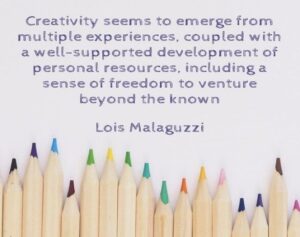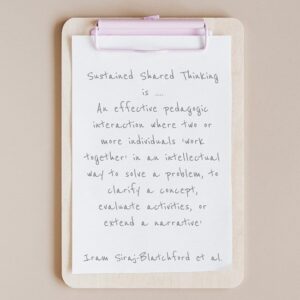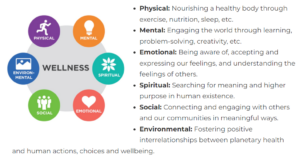Helping integrate academia and research into daily practice. It doesn’t have to be hard!
When I was asked to write this blog entry I found myself pondering my favourite aspects of early years and recent experiences for inspiration. There is so much fantastic research, educational theory, practice and pedagogy that it can feel overwhelming to just pick something to write about let alone integrate the knowledge and research in daily practice. As I considered the richness of our subject, I am reminded of why I love learning and being part of education. It’s that buzz of a lightbulb moment when an idea starts to form suddenly, linking various practices or some research, and the possible creativity available to us to explore topics with inquisitive little minds and excitement/joy that this brings.
A common challenge I encounter in centres is that it can seem difficult in child led environments to plan. Overcomplicating the process or worries about quality, time restraints are just some of the usual suspects that cause the difficulty. However, creativity in education doesn’t have to be complex, in fact we are aiming for the opposite, to allow our children to direct their own learning; in a way that piques their interests and encourages them to explore with support rather than being led. This form of practice is well grounded in Frobelian practice and supported by the research of Allison Clark. Both parties advocate that adult and child have a less hurried approach, resulting in a deeper understanding of a child’s rhythm, pace and interests. This enables children the opportunity to dive deeper into their learning and to revisit and reinvent ideas, creations, places and stories. Slowly knowledge emerges that will last a lifetime, and helps build transferable skills.

We have encountered changes to our planning processes and the TAP Team have been supporting centres with this. Recently I have been partnered with staff in a
centre concentrating on planning, specifically taking ideas from children, developing them with children and providing opportunities that both scaffold and challenge, and also that can last a planning cycle by developing by responding to the children. As I sat with the children drawing flowers as part of the current interest, I was talking about the materials we were using and describing the flowers. I found myself thinking how can I create a further provocation to allow this learning to continue and demonstrate how easy a planning approach can be to the staff?
Following this activity, I started to think and plan provocations and possible lines of development. At this point I sorted my thinking into strands for exploration: – materials, artwork and nature. Sharing my ideas with staff to demonstrate how a simple idea could be broken down into strands to organise the initial stages of planning. I was able to show how with three simple strands we could provide an opportunity for: different learners and their interests; the child who wants to explore different art materials and discover new techniques and ways to use them to create; the child who wants to look at art work of flowers by artists in using various media and materials; the child who wants to explore real flowers, their texture, colour, the parts of the flower or indeed a collection of them all. In this manner the children have the freedom to make their own choices and come up with ideas. We aimed to take an unhurried approach, secure in professional knowledge that this approach was supported by Frobel et al and so we should feel comfortable to allow the children opportunity to really make their own choices and delve into mastering knowledge and skills. We also decided that this approach allowed staff not to have to put out too many resources or provocations. Instead it was better to let the children develop and build their knowledge at a pace that works for their ways and rhythm of learning. It was about quality not quantity.
Our approach to start and help the children’s interests move forward, began by making a gallery of art work for children to look at. We used art from different famous artists using various media as well as micro photography of flowers, to provide stimulus for children and allow them to look closely and develop their drawing skills of the intricate details of plants and flowers. This type of activity is ideal as it provides opportunity for the practitioners to support the children’s discussion, collaboration, language development, listening, reflection – all transferable skills that can be used anywhere. The children have helped to make this gallery display, cutting out the pictures and arranging them on the wall. We are co- creators for this provocation.
For the selection of materials, We have kept it simple for the initial provocation, paper, pencils and colouring pens but I have already encouraged the team to look out other materials to use for when the children choose they want to move on, paints, collage materials, looking out cameras for them to try their own micro photography. We do not know where the learning may go but by being prepared in simplistic ways we can easily adapt and respond to the children ideas, rhythm and pace.
When I am sitting at the table with the children, I try to model, listen, observe, verbalise the thinking processes. I think for many years I have been guilty of just calling it ‘doing my thing, my craft’. However, in recent years I have come to learn that Iram Siraj-Blatchford and her colleagues have given it a much more accessible and understandable term.

To simplify this further; it’s the quality of our interactions that are far more important that the quantity or their novelty. Malaguzzi has a wonderful analogy of how interactions are like playing pass with a ball. Sometimes it’s the child passing the ball, sometimes it’s the adult. Practitioners and myself often question how much they should speak, when sitting doing an activity with children when its child led and I encourage them to take their cue from the children. I always say that I like to try and wait until the child engages with me first.
With the flower activity, I mentioned to the team that I sat alongside the children and begin my own drawing, I model looking intensely at images of flowers or of the artificial flowers on the table, I trace along them with my finger or pencil before mark making on my paper. Not before long the questions come ‘what are you doing?’- My invitation to engage. I share some of my ideas or thinking and ask for their opinion. We go from there, co-operating, communicating, and sharing thoughts and ideas, extending our learning together. I love that moment when I can see in a child’s face that they realise I am not an adult who is going to tell them what to do but an adult who is like them exploring and investigating, learning and that I respect their voice. These types of signal from the children are part of having a quality interaction. Through this type of best practice, it is from these moments that we are able to collect observations and record significant learning for journals, to plan with the child where we are going next and continue our learning journey. When working with staff, I have heard on a number of occasions, is it really this simple? There is a real misnomer in early years that good practice is complex, unattainable and planning and record keeping are too complex to manage alongside educating. However, this immersive learning approach that we advocate stemming from academia and literature, which may seem alien to their daily practice, actually allows the children and practitioners to co-exist and learn from each other that quality outcomes/outputs don’t always originate from volume or pace.
Writing this blog has helped me take time to think about my own craft and interpretation of how I use professional knowledge. We all have our own ways and techniques of interpreting the research to develop our craft, but the foundations remain the same. In these moments of reflection I find happiness that without fully realising it I am both delivering and demonstrating good practice but most importantly help others simplify what they see as a complex and unattainable approach, to provide the best experience for the children in their care.
I think it’s important for not only myself but also our practitioners to find time to reflect on their work too (let’s be honest they have challenging roles at times) and so I invite you all to do that same, especially on a challenging day to reflect and notice not what could have gone better, because in education there is always something that could be better but instead to focus on the elements that are positive, that are going in the right direction and give yourself a pat on the back or notice these things in your colleagues and share this with them. Goodness knows we all need a wee boost every now and then – it’s good for our wellbeing and when our wellbeing is good, we are all better practitioners.

What is Wellness? – Global Wellness Institute
By Laura Walton
References, acknowledgements and further reading.
Malaguzzi, L (1993) History, ideas and basic principles, in C. Edwards, L, Gandini and G. Forman (eds), (2012), ‘The Hundred Languages of Children – The Reggio Emilia Experience in Transformation’ Third Edition, California: Praeger
Siraj-Blatchford, I., Sylva, K., Muttock, s., Gilden,R. and Bell, D. (2002) Researching Effective Pedagogy in the early years. London: DfES
Much of the signposting for further reading and my own understanding has been built from attending Deirdre Grogan training through Strathclyde University over the past 4 years for Play Pedagogy, Exploring Art with young Children, Planning in Early Years and The power of Interaction.
Fisher, J. (2013) Starting from the child, fourth edition. London: Open University Press
Clark, A. (2023) Slow Knowledge and The Unhurried Child -Time for slow pedagogies in Early Childhood Education, Oxan: Routledge
Froebel Trust (2022) Implementing Slow Pedagogy through Froebelian Principled Practice. Froebel Trust | Implementing slow pedagogy through Froebelian…

